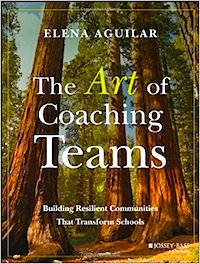Have you ever been in a meeting that was nonproductive? One where someone was monopolizing the conversation or taking it off task? Or one where tempers flared or participants played the blame game?
Chances are, if your group had established norms at the beginning of the meeting, these diversions would be minimized.
I’m currently rereading Elena Aguilar’s very useful book, The Art of Coaching Teams. Today, I was reviewing the norms chapter and happened upon the norms established by the Center for Courage and Renewal, founded by Parker Palmer.
 As I read them, I thought about our current political climate and wondered how these norms might help us all begin to heal our current national divide. The norms are:
As I read them, I thought about our current political climate and wondered how these norms might help us all begin to heal our current national divide. The norms are:
- Be present as fully as possible: Be here with your doubts, fears, and failings, and with your convictions, joys, and successes, with your listening and with your speaking.
- Give and receive welcome: We support each other’s learning by giving and receiving hospitality, kindness, and care. We need this to feel safe to learn.
- Speak your truth in ways that respect other people’s truths: Our views of reality may differ, but speaking one’s truth does not mean interpreting, correcting, or debating what others say.
- When the going gets rough, turn to wonder: Set aside judgment to listen to others and to yourself more deeply. If you feel judgmental or defensive, ask yourself, ‘I wonder what my reaction teaches me about myself?’
- Respond to others with honest, open questions. Instead of trying to fix each other, ask questions to help hear each other into deeper speech.
- Observe deep confidentiality: Nothing said in our team will ever be repeated to other people without each other’s consent. (p. 116)
As I read these norms, I was particularly struck by the fourth norm: When the going gets rough, turn to wonder. The suggestion that, when I’m being judgmental or feeling defensive, I should look inward by asking “What does my reaction teach me about myself?” really made me think.
To be quite honest, I often react by wondering how that person could possibly think such a thing. Or, when I can be more reflective, I wonder why they might think that way. But rarely do I ask myself why I am reacting the way that I am.
So, I’ve decided that I want to try to make a habit out of using that norm when I’m working with others, and when I’m in a discussion with a friend, colleague, or acquaintance. And, looking back, I wish I had embraced this norm months ago.

As we all work to address the current gulf in our political world, or as we go about our important everyday work with colleagues and groups, it might be wise for all of us to keep this norm in our minds and hearts.
Take a moment to review all of the norms listed above. Which one might you want to integrate into the way you work with others? And, how might it make your meeting and/or conversation more productive?
Cathy Gassenheimer is Executive Vice President for the Alabama Best Practices Center, a division of A+ Education Partnership.


0 Comments on "Norms We Can Use for our Everyday Lives – and with Collaborative Groups"